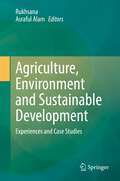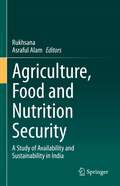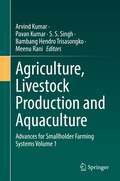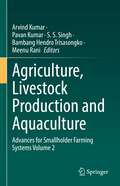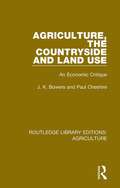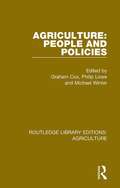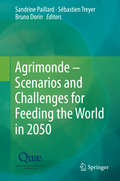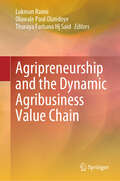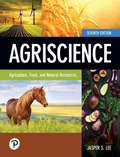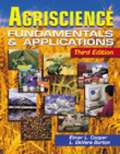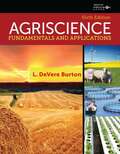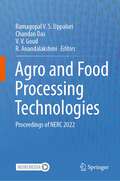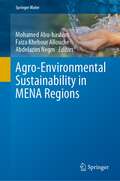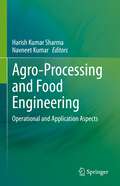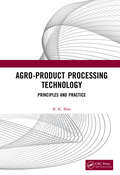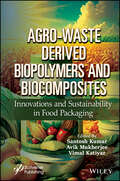- Table View
- List View
Agriculture, Environment and Sustainable Development: Experiences and Case Studies
by Rukhsana Asraful AlamThis volume is intended to provide a comprehensive understanding of recent innovations related to the study of agricultural and environmental management for sustainable development. The book clearly identifies why the fight to achieve sustainable development in agricultural production must be fought along a broad multidisciplinary front to overcome issues such as soil erosion, poor water quality, pesticide contamination, and food insecurity. Readers are given a broad exposition of the trends and current practices of basic principles on sustainable agriculture, along with a detailed understanding of the use of sustainable agriculture to develop environmentally sustainable food production systems. The chapters describe the ecological sustainability of agricultural systems, current innovations to improve efficiency in the use of resources for sustainable agriculture, and the proposal for technological options and new areas of research in this very significant field of agriculture. The authors aim to provide readers with a good subject understanding which will assist in the identification of agricultural development, environmental risk, sustainable resource management and design of appropriate responses. This book will be very helpful for students, researchers and practitioners interested in the fields of agriculture, environment and sustainable development.
Agriculture, Food and Nutrition Security: A Study of Availability and Sustainability in India
by Rukhsana Asraful AlamThis volume provides an interdisciplinary collection of studies that cover the trends and issues related to agricultural productivity and availability, food and nutrition security, and sustainability in India. The book discusses a broad range of vital issues concerning the production and consumption of food during the era of climate change, and has been prepared to generate awareness of these issues in a large agricultural economy to shed light on new perspectives and solutions to achieve sustainable food production and security in India. The book is organized into three major sections: Climate and Agricultural Productivity for Availability, Changes and Trends in Cropping Patterns and Food Security, and Food and Nutrition Security for Sustainable Development. The book will be of interest to students, researchers, policymakers, and other inquisitive readers interested in different aspects of agriculture, food and nutrition security, and sustainable development.
Agriculture, Livestock Production and Aquaculture: Advances for Smallholder Farming Systems Volume 1
by Arvind Kumar Pavan Kumar Meenu Rani S. S. Singh Bambang Hendro TrisasongkoThis two-volume set discusses recent approaches and technological innovations for sustainable agriculture in smallholder farming systems impacted by climate change. The systems covered include crop-based agricultural production, as well as aquaculture and livestock production as related systems using similar techniques to combat food security issues brought about by climate change and resource overuse. The chapters detail innovations involving crop diversification, soil resilience management, geoinformatics and land suitability monitoring for smart farming, information technology in livestock production, and nutrient resource management in fishery aquaculture. Researchers, practitioners and industries will be able to use this information to implement socially and economically sustainable practices to achieve food security in impoverished areas vulnerable to climate change, while also learning about the rapid evolution in information technology that is applicable for and available to small holder farmers. Volume 1 focuses on current innovations in agricultural and livestock practices in response to climate change. It covers the technological challenges, approaches and mitigation strategies encountered by both scholars and practitioners working in livestock and agricultural production systems impacted by climate change.
Agriculture, Livestock Production and Aquaculture: Advances for Smallholder Farming Systems Volume 2
by Arvind Kumar Pavan Kumar Meenu Rani S. S. Singh Bambang Hendro TrisasongkoThis two-volume set discusses recent approaches and technological innovations for sustainable agriculture in smallholder farming systems impacted by climate change. The systems covered include crop-based agricultural production, as well as aquaculture and livestock production as related systems using similar techniques to combat food security issues brought about by climate change and resource overuse. The chapters detail innovations involving crop diversification, soil resilience management, geoinformatics and land suitability monitoring for smart farming, information technology in livestock production, and nutrient resource management in fishery aquaculture. Researchers, practitioners and industries will be able to use this information to implement socially and economically sustainable practices to achieve food security in impoverished areas vulnerable to climate change, while also learning about the rapid evolution in information technology that is applicable for and available to small holder farmers. Volume 2 focuses on trends and technologies in food security within the context of sustainable practices, drone technology, microwave data, molecular farming, machine learning, agricultural economics, spatial modeling and agricultural policy. These chapters discuss advancements in fishery resource and aquaculture practices, and also the challenges facing these areas due to climate change.
Agriculture, Recreation, Water Quality and Nature Protection in the Hula Valley, Israel: 70 years of a Mega-ecological Project (Springer Geography)
by Moshe GophenThe anxious search for agricultural income resources, and assurance of the national water supply in the northern newly created state of Israel initiated the national project of the Hula Drainage. The implementation of this project was accompanied as of today by research and monitoring of the ecological trait aimed at crop harvest improvement in the Hula valley and prevention of water quality deterioration in Lake Kinneret. Forty years later a reclamation project to improve the peat soil property and renovate the hydrological system was carried out. This book documents the scientific research carried out during this mega-ecological project. Several issues of the ecological renovation and its impact on the Hula valley management and water quality in lake Kinneret are presented in this book. The advantage and contribution of a newly created shallow lake Agmon-Hula to nutrient dynamics, and hydrological control, accompanied by avian presence, (among others, Cranes, Storks, Pelicans, Flamingoes) and plants renewal which enhanced, tourism; potential impact of nitrogen and sulfate migration from the Hula valley on the Kinneret water quality; the role of climate change on the ecology of the Hula Valley and the Kinneret nutrient availabilities and phytoplankton community; the subterranean migration of water and nutrients and water loss. Further proposals for future development are under consideration. This book presents a comprehensive practical management implementation of a long-term ecological project. Results of scientific and monitoring research which followed the project implementation benefit the international and national communities.
Agriculture, the Countryside and Land Use: An Economic Critique (Routledge Library Editions: Agriculture #4)
by J. K. Bowers Paul CheshireFirst published in 1983. How had the situation developed in which agriculture had become such a creature of state protection, where public money supported prosperous landowners while poor farmers received practically nothing? Where the value of agricultural support exceeded net farm income, and vastly exceeded the level of support available to British Steel or British Rail? In answering these questions John Bowers and Paul Cheshire examined the real value of agricultural support in successive policy phases since the Second World War, and analysed the effects this support had on income distribution. Their thesis was that agricultural change, including the transfer of land from traditional farmers to institutions and corporations, was not the product of impersonal progress, but the direct result of agricultural support policies, resting on specious economic arguments. The authors’ analysis of this subject has inescapable relevance for the policymaker, for the taxpayer and consumer of foodstuffs, for the urban user of the British countryside and indeed for farmers and the farming lobby. Agriculture, the Countryside and Land Use will be an important book for all these groups and also for students of agriculture, geography and economics.
Agriculture: People and Policies (Routledge Library Editions: Agriculture #5)
by Michael Winter Philip Lowe Graham CoxThe structure and future of Britain’s agriculture sector are the central concerns of this volume, first published in 1986. It critically examines the mystique surrounding agriculture which has done much to underpin the special support the industry had enjoyed. The papers collected here address many of the key questions: What is distinctive about the social and economic organisation of agricultural production? What are the main factors which have influenced policy formation? And how are the policy makers likely to respond to widespread concern about the economic and environmental impact of those policies?
Agrimonde - Scenarios and Challenges for Feeding the World in 2050: Scenarios And Challenges For Feeding The World In 2050
by Sandrine Paillard Sébastien Treyer Bruno DorinHow will the world be able to feed close to 9 billion people in 2050 and still maintain the ecosystems? In this perspective, INRA and CIRAD launched the initiative, in 2006, to develop a foresight project for analysing issues pertaining to the world's food and agricultural systems on the 2050 timeline. This book provides a synthetic presentation of the main conclusions that this foresight project has yielded. First, it recapitulates the main statistical references for the period 1961 to 2003, before going on to describe the Agribiom simulation tool used to calculate food biomass resource use balances. Two scenarios on the 2050 timeline are then considered: Agrimonde GO is a trend-based scenario that bets on economic growth to feed the world, in a context where environmental protection is not a priority; in contrast, the idea in Agrimonde 1 is to feed the world while preserving its ecosystems.
Agripreneurship and the Dynamic Agribusiness Value Chain
by Lukman Raimi Olawale Paul Olatidoye Thuraya Farhana Hj SaidThis book provides an insightful exploration of agribusiness entrepreneurship in the dynamic landscape of the global economy. Targeted at agribusiness researchers, agricultural scientists, finance professionals, and consultants, the thematic focus encompasses agricultural and business entrepreneurship, production and consumption dynamics, ethical considerations, impact investments, and disruptive technologies such as Bitcoin, digital ventures, cryptocurrency, and blockchain. Addressing the principles governing innovative business models, the text delves into the multifaceted realm of entrepreneurship in agriculture, with a specific emphasis on Sustainable Development Goals (SDGs) and the integration of science, technology, engineering, and mathematics (STEM) in agribusiness. The book underscores the pivotal role of agripreneurs in driving agricultural activities, employing mechanization, irrigation, and modern farming technologies to augment production. It navigates the complexities of rural entrepreneurial activity, considering factors like location, natural resources, social capital, and information technologies. Furthermore, the book investigates the necessity for an entrepreneurial culture in agriculture, citing its potential to alleviate challenges, create employment opportunities, curb rural-to-urban migration, and enhance national income. Through a pragmatic lens, it explores the educational processes required for farmers to develop entrepreneurial and organizational skills, emphasizing the significance of such skills in fostering sustainable development. A comprehensive examination of entrepreneurship in agriculture, this book stands as an indispensable resource for those seeking a nuanced understanding of agribusiness dynamics, the integration of innovative technologies, and the role of entrepreneurship in shaping the future of agriculture.
Agriscience (4th Edition)
by Jasper S. Lee Diana L. TurnerAgriScience is a student- and teacher-friendly book that blends physical and biological science with the fundamentals of agriculture. Since agriculture is largely applied science, this is a highly useful and practical approach. Principles of science are presented and reinforced using agricultural applications.
Agriscience: Agriculture, Food, And Natural Resources
by Jasper S. LeeThis book will help you move ahead in learning. With over 25 years since the first edition, and numerous editions since, there is a lot in this book that has been tried and proven. Beginning with the first edition in 1993, emphasis has been on usefulness of the book as a teaching-learning tool. The focus continues to be on approaches that blend science with agriculture, food, and natural resources (AFNR). Students, teachers, parents, agriculturalists, scientists, and many others have provided input that shaped this revised edition. Of course, national, state, and local standards have been used in this process. The goal of the author with this and previous editions has been to produce the best possible book for introductory science-based agricultural education classes. With over a thousand pages, more than 900 illustrations, and 30 carefully designed and written chapters, you are on to something special with this book.
Agriscience: Fundamentals And Applications (3rd edition)
by Elmer L. Cooper L. Devere BurtonThis third edition of "Agriscience: Fundamentals & Applications," addresses the basic levels of modern agriscience concepts using language and examples designed to meet the needs of beginning students interested in natural science careers. The text integrates broadened principles of agriculture through all the major science areas, and adds many new applications of science, technology, math, agriculture, natural resources and the environment. New full-color photographs and illustrations have been added for visual enhancement, as well as internet icons to help students explore agriscience topics beyond the boundaries of the text. The unit profiles and student activities provide instructors with innovative ways to teach modern agriscience concepts, as this book contains invaluable resources for introductory agriscience curriculums.
Agro and Food Processing Technologies: Proceedings of NERC 2022
by Chandan Das Ramagopal V. S. Uppaluri V. V. Goud R. AnandalakshmiThis book focuses on sustainable agro and food technologies for the northeast region of India and provides holistic insights into relevant and contextual scientific and technical advances in the agro-food sector. Agriculture is an important livelihood avenue for many residents of northeast India. Low-cost scientific and technological intervention can transform agricultural farm produces and generate farm waste into processed value-added products. This book will serve as a valuable resource to further enhance the linkage between managerial aspects and technological knowledge systems in this field and eventually catalyse potential knowledge frameworks for the long-term prosperity and sustainability of bio-diversity-rich North-east India. It emphasizes the research culture that needs to be adopted for the most relevant food and agro-processing technologies for the sustainable growth and prosperity of the region.
Agro-Environmental Sustainability in MENA Regions (Springer Water)
by Mohamed Abu-Hashim Abdelazim Negm Faiza Khebour AlloucheThis book focuses on the status quo and the latest information on the water-soil-agriculture nexus in the MENA countries. It presents several case studies and applications from e.g. Morocco, Algeria, Tunisia, Egypt and Jordan, while also sharing and discussing the latest findings. The content includes a range of agriculture-related topics that focus on: water resources management, impacts of climate change, and wastewater treatment for reuse in agriculture sectors; in addition, sustainable approaches to agricultural-based industry, organic crop production, crop water requirements, and soil environment are discussed in an updated and comprehensive review. In turn, the book discusses the applications of GIS and remote sensing as a new technology for better agriculture management, as well as its use in Egypt as a representative country. In closing, it considers the implementation of an environmental information system in data-scarce MENA countries from the standpoint of the water-food nexus, and addresses the question of climate justice in the MENA region. Exploring various dimensions of MENA country-based case studies on achieving sustainable agriculture, the book offers an invaluable source of topical information for agricultural sustainability-related stakeholders in the region, researchers and graduate students alike.
Agro-Processing and Food Engineering: Operational and Application Aspects
by Harish Kumar Sharma Navneet KumarThis textbook highlights the engineering fundamentals and processing aspects of agricultural produce and covers important aspects of agro-processing and food engineering in one place. The chapters cover material handling, drying, size reduction process, mixing and forming, cleaning and separation, storage, and processing of cereals, pulses, oilseeds, fruit and vegetables, and their products. The book’s contents are systematically designed to provide a balanced overview of agro-processing techniques from the basic concepts to the case study, handling of the materials, and different unit operations. The systematic and simple elaboration of scientific aspects will make it unique and help to develop skills in the field. Many illustrations in form of diagrams/charts/pictures provide a clear understanding. Solved numerical problems, which are given in the chapters, will provide students clarity in conceptualizing the basics. The book covers the syllabus related to agro-processing and food engineering at the undergraduate and postgraduate level in various universities, agricultural universities, allied institutes, and colleges across the globe. It will be extremely beneficial to students as it covers the most important and relevant topics, which are hardly covered in any other single compilation and published textbooks. It would be a good textbook for universities, agricultural universities, institutes, and colleges running courses in agriculture, horticulture, postharvest technology, process and food engineering, food engineering, food engineering and technology, food technology, food science, and food and nutrition.
Agro-Product Processing Technology: Principles and Practice
by B K BalaGlobal food security is a challenging issue. Meeting the food and nutritional requirements of the world has become an issue for national policymakers and is of public concern. There is a need to enhance agricultural production, as well as, to reduce postharvest loss, improve the quality of processed products, and add value to products to make more quality food available. Agro-product processing technology plays a major role to reduce post-harvest losses, improve the quality of processed products, and add value to the products. It also generates employment and ultimately contributes to food security. Features: Covers a wide spectrum of agro-product processing technology Explains the principles and practices of agro-product processing technology with many worked examples to quickly teach the basic principles through examples Contains examples from different operations on current problems to show the wide applications of the principles of agro-product technology Includes process control and emerging technologies in agro-product processing such as energy and exergy analysis, neural network modeling, and CFD modeling This book deals with physical and thermal properties, cleaning and sorting, drying and storage, parboiling and milling, by-product utilization, heating and cooling, refrigerated cooling, and cold storage. The most unique feature of this book is the machine vision for grading fruits, process control and materials handling, and emerging technologies such as neural network, finite element, CFD, and genetic algorithm.
Agro-Technology
by R. Paul ThompsonHumans have been modifying plants and animals for millennia. The dawn of molecular genetics, however, has kindled intense public scrutiny and controversy. Crops, and the food products which include them, have dominated molecular modification in agriculture. Organisations have made unsubstantiated claims and scare mongering is common. In this textbook Paul Thompson presents a clear account of the significant issues - identifying harms and benefits, analysing and managing risk - which lie beneath the cacophony of public controversy. His comprehensive analysis looks especially at genetically modified organisms, and includes an explanation of the scientific background, an analysis of ideological objections, a discussion of legal and ethical concerns, a suggested alternative - organic agriculture - and an examination of the controversy's impact on sub-Saharan African countries. His book will be of interest to students and other readers in philosophy, biology, biotechnology and public policy.
Agro-Waste Derived Biopolymers and Biocomposites: Innovations and Sustainability in Food Packaging
by Santosh Kumar Vimal Katiyar Avik MukherjeeAGRO-WASTE DERIVED BIOPOLYMERS AND BIOCOMPOSITES This comprehensive book describes the fundamental principles and major advancements in the utilization of agro-waste for deriving biopolymers, and their applications to fabricate composite, nanocomposite, and hybrid food packaging films and coatings. The book serves as a complete, systematic, comprehensive account of the contemporary developments in the area of novel and environment-friendly valorization of agro- and food wastes into value-added products like biodegradable polymer and active functional agents for food packaging applications. It also describes the hurdles and challenges in the commercialization of these novel biopolymer-based materials, including their composites, their applications, safety, and legal ramifications. This book consists of fifteen chapters covering different aspects of agro- and food waste utilization, the development of biodegradable polymers, and their composites for sustainable food packaging applications. The first thirteen chapters detail the processing of various agro- and food wastes of plant and animal origin to synthesize different biopolymers, such as starch, cellulose, chitosan, silk proteins, pectin, etc., and their applications for the fabrication of sustainable food packaging materials and composites that are attractive alternatives to synthetic plastic packaging. These chapters also summarize the effectiveness of these biopolymers and their composites in developing active films and edible coatings for shelf-life extension and preservation of perishable foods. A chapter is devoted to issues of biodegradability, including analyses of various biodegradation reactions, such as depolymerization, mineralization, biochemical, and abiotic degradation both in soil and aquatic environments. The book concludes with a chapter addressing the concerns associated with the possible migration of components or additives from these biodegradable packaging into packaged food items. Audience The primary audience for this book is researchers, scientists, and engineers working in food science and technology, food engineering and technology, food biotechnology, sustainable food packaging, etc. Additionally, food entrepreneurs and associated businesses, such as the packaging and coatings industries, will also have a keen interest in the book.
Agro-biodiversity and Agri-ecosystem Management
by Pavan Kumar Meenu Rani Jahangeer A. Bhat R. S. Tomar Manmohan DobriyalThis edited book collates latest findings in the field of agro-biodiversity and agri-ecosystem management across the globe through selected case studies. The primary aim of the book is to cover agro-biodiversity and agri-ecosystem advancements in the field of agricultural resource management. The book explores a range of technologies that support sustainable use of resources and facilities, such as Natural Resource Management (NRM), Resource Conservation Technologies (RCTs), Integrated Farming System (IFS), Integrated Crop Management (ICM), Integrated Nutrient Management (INM), use of solar energy, promotion of agro-ecological zone specific agricultural production, application of climate resilient technologies, secondary agricultural practices and post-harvest technologies. Agro-biodiversity and agri-ecosystem not only contributes to overall growth of the economy but also reduces poverty by providing employment and food security to the majority of the population in the continent and thus it is the most inclusive growth sectors of the economy of Asian and African countries. The book is relevant for researchers and policy makes in the field of agriculture, food system research, ecology, agricultural diversification, resource management etc.
Agro-geoinformatics: Theory and Practice (Springer Remote Sensing/Photogrammetry)
by Liping Di Berk ÜstündağThis volume collects and presents the fundamentals, tools, and processes of utilizing geospatial information technologies to process remotely sensed data for use in agricultural monitoring and management. The issues related to handling digital agro-geoinformation, such as collecting (including field visits and remote sensing), processing, storing, archiving, preservation, retrieving, transmitting, accessing, visualization, analyzing, synthesizing, presenting, and disseminating agro-geoinformation have never before been systematically documented in one volume. The book is edited by International Conference on Agro-Geoinformatics organizers Dr. Liping Di (George Mason University), who coined the term “Agro-Geoinformatics” in 2012, and Dr. Berk Üstündağ (Istanbul Technical University) and are uniquely positioned to curate and edit this foundational text.The book is composed of eighteen chapters that can each stand alone but also build on each other to give the reader a comprehensive understanding of agro-geoinformatics and what the tools and processes that compose the field can accomplish. Topics covered include land parcel identification, image processing in agricultural observation systems, databasing and managing agricultural data, crop status monitoring, moisture and evapotranspiration assessment, flood damage monitoring, agricultural decision support systems and more.
Agro-industrial Perspectives on Sugarcane Production under Environmental Stress
by Vishnu D. Rajput Krishan K. Verma Xiu-Peng Song Sushil Solomon Yang-Rui Li Govind P. RaoThis edited volume focuses on the core aspects of sugarcane production-management under stressful environments as well as innovative strategies for augmenting crop growth & productivity through intrinsic and extrinsic manipulations. The various chapters aim at bringing out comprehensive and advance information on different aspects of sugarcane cultivation under stress environments and impact of climate change on the sustainability of sugarcane production. The book encompasses information about crop production management, physiological & nutritional requirements, ratooning, ripening and post-harvest losses management. It also delineates various technologies that support the continued use and improvement of sugarcane as renewable source of food, fiber and bio-energy. The manipulations at cellular and molecular levels, molecular breeding approaches and post-harvest technologies are also included. The area under sugarcane cultivation is gradually increasing because of its diversification potential. The high productivity and biomass of the cane crop also makes it a key source for use as bio-energy crop and a promising raw material for bio-based agro-industries. However, poor crop & biomass productivity due to abiotic stress is the foremost constraint in its future commercial exploitation as sustainable feed-stock for bio-based industries. It is therefore imperative to understand the cellular-molecular modulation responsible to productivity barrier under specific stress situation(s) for better sugarcane quality and quantum under field condition. Some of these innovative approaches are delineated in this book. This book is of interest to progressive sugarcane growers, millers, industrial entrepreneurs, sugarcane scientists, cane development and extension officers, sugar industry managers and valuable source of reference worldwide.
Agro-industrial Waste for New Pharmaceuticals: Sustainable Sources of Bioactive Compounds (Green Energy and Technology)
by Allana Katiussya Silva Pereira Ananias Francisco Dias JúniorThis book is written to foster discussions on the valorization of agro-industrial waste as a raw material for bioactive compounds that can assist in disease containment, the protection of soil resources, and consequently, human health. The agro-industry encompasses a broad spectrum of activities focused on transforming raw materials from agriculture, livestock, aquaculture, and forestry. In addition to producing a diverse range of goods, these processes generate substantial amounts of residual biomass from various cultivation and processing systems. In this context, the intensification of climate change and the overexploitation of natural resources have been major drivers of emerging infectious diseases. A recent and impactful example is SARS-CoV-2, which escalated into a global pandemic with severe mortality rates. Additionally, Latin America has experienced a sharp rise in dengue cases, prompting the Pan American Health Organization to issue an epidemiological alert due to the increasing incidence of arboviruses across the region. Given the need to explore possibilities for valuing and utilizing agro-industrial waste, this book presents the potential of this material in the context of human health. The authors present a comprehensive review of recent research on pyroligneous liquid as a rich source of bioactive compounds, alongside the use of biochar and bone char in water treatment and herbicide immobilization in soil. Additionally, the book provides an in-depth analysis of methodologies for extracting bioactive compounds from &“açaí&” (Euterpe oleracea and E. precatoria) waste, highlighting its potential for high-value applications. In this way, the book highlights the challenges and opportunities to transform these materials into beneficial resources, both for the environment and for society, contributing to the advancement of public health and environmental conservation in the context of climate change.
Agro-waste to Microbe Assisted Value Added Product: Recent Developments in Agro-waste Valorization Research (Environmental Science and Engineering)
by Swarnendu Roy Piyush Mathur Shyama Prasad Saha Deepika MazumdarThis book mainly focuses on the recent trends and sustainability challenges in the valorization of agro-wastes, emphasizing the role of microbial biotechnology. Processing of various kinds of agro-wastes such as lignocellulosic materials, food industry wastes, dairy wastes, etc., into several bioactive compounds, enzymes, biofuels, biogas, biofertilizers, nutraceuticals, nanoparticles, etc., will be discussed elaborately in more detail. This book investigates the theoretical and practical aspects of modern research regarding the valorization of agro-wastes through microbial technology. Moreover, the role of valorization research in circular bio-economy will also be addressed in this book.
Agrobacterium Biology: From Basic Science to Biotechnology (Current Topics in Microbiology and Immunology #418)
by Stanton B. GelvinThis volume reviews various facets of Agrobacterium biology, from modern aspects of taxonomy and bacterial ecology to pathogenesis, bacterial cell biology, plant and fungal transformation, natural transgenics, and biotechnology. Agrobacterium-mediated transformation is the most extensively utilized platform for generating transgenic plants, but modern biotechnology applications derive from more than 40 years of intensive basic scientific research. Many of the biological principles established by this research have served as models for other bacteria, including human and animal pathogens. Written by leading experts and highlighting recent advances, this volume serves both as an introduction to Agrobacterium biology for students as well as a more comprehensive text for research scientists.
